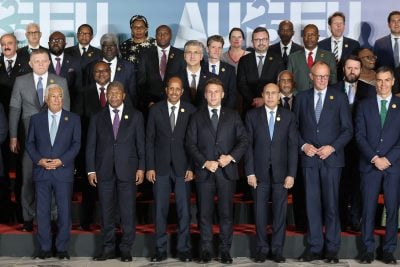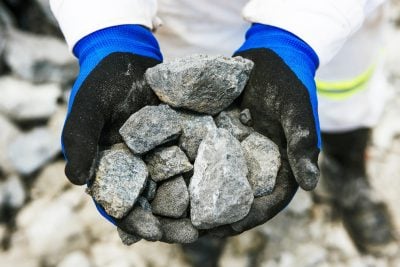President Mokgweetsi Masisi basked in a moment of triumph on 22 August, as he unveiled the largest diamond discovered anywhere in the world for more than a century to an excited crowd of journalists and officials in Gaborone. “What?!” he exclaimed, his eyes popping with delight as he felt the weight of the stone. “I am lucky to have seen it in my time.”
The presentation of the second-largest diamond ever wrenched from the Earth appears to be the latest glittering chapter in Botswana’s success story. The stone, extracted from the Karowe mine by Canadian company Lucara, provides seemingly irrefutable evidence that the southern African nation remains a diamond superpower.
“We are ecstatic about the recovery of this extraordinary 2,492-carat diamond,” said William Lamb, president and CEO of Lucara in a statement. “This discovery reinforces Karowe’s position as a truly world-class diamond mine.”
Lamb’s ecstasy is unsurprising, given that the stone is thought to be worth more than $40m. His joy must have increased further when the company announced another find, weighing in at 1,094 carats, just weeks later. Lucara recovered these diamonds through x-ray transmission technology that it installed at Karowe in 2017. Diamondiferous ore is scanned before it goes through the mechanical crushing process, enabling the company to identify and preserve exceptionally large stones.
Competition from the labs
But the long-term outlook for the industry in Botswana looks less rosy. Even the recent discovery of such enormous riches cannot disguise the fact that Botswana’s diamond mining industry is facing serious headwinds.
“The basic problem with diamond mining is that synthetic, lab-grown diamonds are getting cheaper and better,” says mining historian Duncan Money. “It’s now hard to distinguish between natural and synthetic diamonds. If people are happy with synthetic diamonds, then why mine natural ones?”
He does note that the discovery of the 2,492-carat diamond is “good news, because a diamond of this size is something distinct and eye-catching, it adds something to the romance and desirability of the stones.” The giant diamond represents “good publicity for Botswana too, as a place where large, high-quality diamonds are discovered.”
“Beyond this, what does it mean for Botswana?” Money asks. “Not much. It doesn’t change the basic outlook for the diamond industry.”
Losing its shine
One of the poorest and least-developed places in the world at independence in 1966, Botswana is now among the wealthiest countries in Africa. Its per capita income of around $19,000 is similar to Brazil’s. The World Bank classifies Botswana as an upper-middle-income country, one of just eight in Africa.
There are several reasons for Botswana’s relative prosperity. It has never suffered from sustained political violence. Elections have been held regularly ever since independence. And Botswana has proven far more successful than most of its peers in curtailing corruption: it is the third-best performing country in Africa in Transparency International’s latest Corruption Perceptions Index.
But the role of diamonds in Botswana’s economic development is impossible to overlook.
The young country received a huge stroke of luck in 1967, just one year after independence, when diamond mining giant De Beers came across diamond deposits at Orapa, around 250 miles from Gaborone. Since then, several other deposits have been brought into production.
Botswana is now the largest diamond exporter in the world by value, and the second largest by volume. The government has proven adept at maximising its share of diamond revenues. It negotiated what consultant Keith Jefferis describes as a “very favourable deal” to form Debswana, a joint venture with De Beers, in 1968.
“The terms of the revenue-sharing deal were progressively improved over time through many rounds of negotiations,” Jefferis noted in recent analysis for the International Monetary Fund (IMF). The government now receives almost 85% of the profits from diamond mining. A new deal, signed last year after lengthy negotiations, reinforced this trend.
Visible benefits
The benefits that diamond mining has brought to Botswana are visible in the paved roads, the healthcare facilities and the schools and universities that are funded largely through diamond revenues. But the country’s dependence on diamonds also represents an obvious liability.
“Botswana is facing a severe slowdown,” an IMF delegation warned earlier this month following consultations with Botswana’s government. It predicts that GDP growth will shrink to just 1% in 2024, down from 2.7% last year and 5.5% in 2022. The blow to the economy “reflects weaker global demand for diamonds and a sharp increase in inventories,” the IMF said.
Botswana generates 80-90% of its export revenues from diamonds in a typical year. The country’s dependence on a single industry – even one as lucrative as diamonds – leaves it severely exposed to fluctuations in the global market. Diamonds are a finite resource – and the growth of synthetic alternatives poses a clear challenge to the diamond mining industry.
Botswana’s leaders have been aware of the dangers of diamond over-dependence for decades. There have been no shortage of plans and projects to diversify Botswana’s economy in recent years. Time is now running out for other sectors of the economy to take-off if Botswana is to extend its track record of economic success.
Growing success
At Selebi Phikwe, a dusty town in the east of Botswana, efforts to transform the country’s economy are slowly taking shape. In March, President Masisi descended on the area to mark the first harvest of fruits at the Selebi Phikwe Citrus farm, a major agribusiness project that he inaugurated four years earlier. The first harvest at the 1,500-hectare site, which grows grapefruits, lemons, mandarins and oranges, “epitomises a prologue in our journey to achieve export-led growth,” the president said.
“This project is not just about cultivating citrus fruits; it’s about cultivating hope, economic growth, and a sustainable future for Botswana,” effused Pieter Scholtz, the South African agribusiness entrepreneur who serves as CEO of Selebi Phikwe Citrus. Ownership of the project is split among Scholtz’s company Blydevallei Citrus, fruit trading company AfriGold and a consortium of investors from Botswana. The government has backed the scheme through the Botswana Investment and Trade Centre and SPEDU, a local economic diversification agency. The European Union also chipped-in with technical assistance.
The horticulture business, which includes a 12,000-square-metre packhouse, intends to export around 70% of its produce. However, since the harvest ceremony six months ago, not everything has gone to plan. The farm found that much of its grapefruit crop had blemishes, making it unsuitable for international markets. Desperate to dispose of unwanted produce, it invited local farmers to collect low-grade fruit for use as animal feed in May. But a large quantity ended up dumped on the roadside, generating unwanted headlines in local media.
The farm said in a statement that it is making plans to export low-grade fruits to juice factories and that the dumping incident was the result of a “one-off problem”.
The reality is that Botswana badly needs agribusiness projects such as Selebi Phikwe Citrus to succeed. The scheme is set to generate 1,500 jobs once it reaches peak production, a significant number for a country with a total labour force of just 1.2m. In fact, the town of Selebi Phikwe has been in special need of an economic boost ever since a nearby copper and nickel mine ceased operations in 2016.
Indeed, for all Botswana’s success in becoming a leader in diamond extraction, and to some extent in value-added processing industries, diamonds alone have never provided enough jobs. The World Bank notes that unemployment is “structurally high”, at more than 25%. Youth unemployment is almost 35%.
Digging deep for diversification
The good news is that, outside of diamonds, other segments of the mining industry enjoy a more positive outlook. “Copper production provides the most immediate source of economic diversification,” notes Lyle Begbie, an economist at Oxford Economics Africa. Buoyed by soaring global demand for energy and electrification projects, Begbie says that copper mining is “starting to rise from the ashes again” in Botswana. He expects copper output to rise by over 50% this year, largely due to the ramping-up of production at the Motheo mine, operated by Australia-based Sandfire Resources.
Several other copper projects are at varying stages of development. A Canadian company, Premium Nickel Resources, is looking to restart operations at the shuttered Selebi Phikwe mine. As well as mining and agriculture, tourism is a major strength, thanks largely to the country’s remarkable biodiversity. Arrivals in the first quarter of 2024 were up 18% from the same period last year, according to Statistics Botswana. Including its indirect contributions, tourism accounts for nearly 10% of GDP.
The government passed legislation to establish eight special economic zones in 2015, each of which aims to promote certain sectors, including agri-business, manufacturing and ICT. But for further progress towards diversification, Botswana will need to tackle some of its longstanding challenges.
In a 2022 report, the World Bank’s International Finance Corporation listed infrastructure bottlenecks as a key factor in limiting Botswana’s economic diversification. The country relies on imports from South Africa to meet around half its electricity demand – but it is making tangible progress with renewables. Norwegian company Scatec commenced construction on the country’s largest solar farm in March. The 120 MW project represents “a step towards sustainability, energy independence and economic growth for Botswana” said Scatec CEO Terje Pilskog.
Increasing the supply of low-cost renewable power will be vital if power-intensive industries are to have any chance of taking off. Improving logistics infrastructure is another priority, with the proposed Trans-Kalahari Railway between Gaborone and the Port of Walvis Bay in Namibia set to facilitate mining and manufacturing exports.
Development partners have also waged a long-running campaign to persuade Botswana to rein-in state-owned enterprises. The World Bank warned in a report last year that “competition in sectors such as energy, beef, and transport is dampened by the large public sector footprint and the preferential treatment of some state-owned enterprises”. It added that subsidies to parastatal firms “create distortions that discourage competitiveness and diversification”.
Political stability
Meanwhile, as Botswana prepares for elections next month, maintaining political stability will be key to improving investor confidence. A feud between President Masisi and his predecessor, Ian Khama, has sent shockwaves through the country’s usually sedate politics. Khama returned from self-imposed exile in September to campaign for opposition parties seeking to unseat Masisi. He will also face criminal charges over alleged money laundering and firearms offences.
Khama’s return “is likely to escalate tensions and frustrate the current regime,” says Begbie, although he anticipates that Masisi will secure a second term. “The main questions are: will the [ruling Botswana Democratic Party] maintain its majority, and will the opposition make significant gains or simply split the vote in key constituencies.”
The political turbulence adds to the sense that Botswana is coming to a crossroads.
Yet despite its challenges, Botswana remains in an enviable position compared to most other African countries. The task for whichever party wins the upcoming election is to build on the strengths that have been built-up over decades and move the country into the next phase of economic development.
Want to continue reading? Subscribe today.
You've read all your free articles for this month! Subscribe now to enjoy full access to our content.
Digital Monthly
£8.00 / month
Receive full unlimited access to our articles, opinions, podcasts and more.
Digital Yearly
£70.00 / year
Our best value offer - save £26 and gain access to all of our digital content for an entire year!

 Sign in with Google
Sign in with Google 



